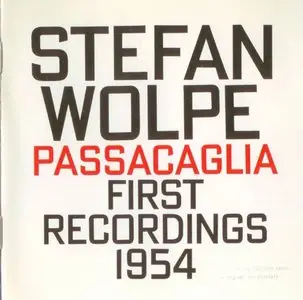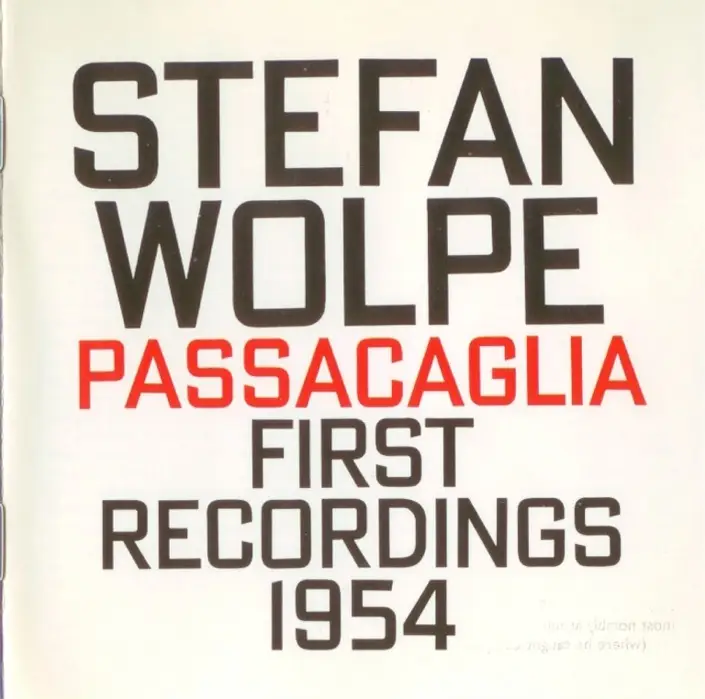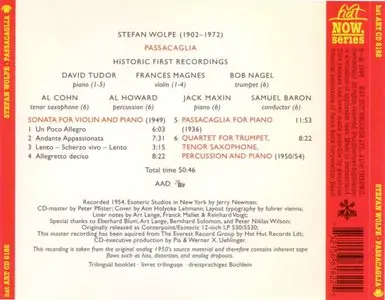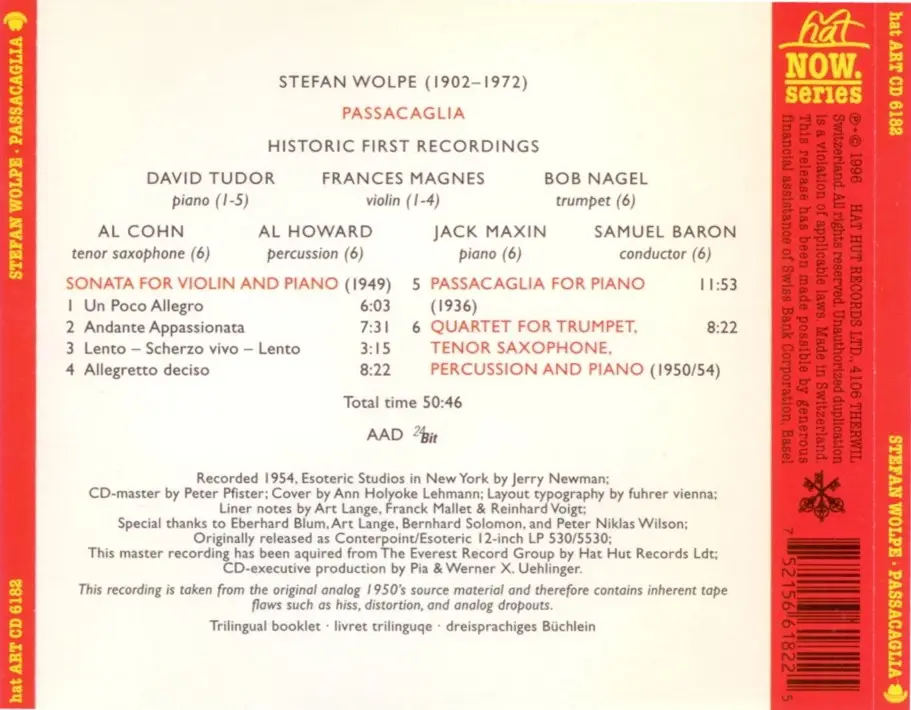Stefan Wolpe - Passacaglia (1996)
EAC RIP | APE + CUE + LOG | COVER + BOOK | RAR FILES (3% recovery) | 160 Mb
Classical | hat ART CD 6182
EAC RIP | APE + CUE + LOG | COVER + BOOK | RAR FILES (3% recovery) | 160 Mb
Classical | hat ART CD 6182
Tracklist:
1-4. SONATA FOR VIOLIN AND PIANO
5. PASSACAGLIA FOR PIANO
6. QUARTET FOR TRUMPET, TENOR SAXOPHONE, PERCUSSION AND PIANO
These historic recordings, available for the first time in nearly half a century, mark the first recorded work of maverick composer and teacher Stefan Wolpe. The three selections here, "Sonata for Violin and Piano" (1949), "Passacaglia for Piano" (1936), and "Quartet for Trumpet, Tenor Saxophone, Percussion and Piano," (1950/1954) were recorded exceptionally by Jerry Newman in Esoteric Studios in New York, shortly before Wolpe left his post at Black Mountain College and moved permanently to New York City where he became a friend and colleague to the still burgeoning New York artists scene filled with composers and poets. Wolpe had been an instructor of Morton Feldman's in 1944 and metCage near the same time that had recommended him for the Black Mountain post. In listening to these pieces, what becomes immediately apparent is Wolpe's signature: his lack of formal structure, the free-flowing fantasias all of his pieces eventually become – especially the later, post-1950 works. One would never have guessed that Wolpe had ever studied with Anton Webern. The music Wolpe created is one of constant movement and abstraction with one element holding it all together: counterpoint. In the four-movement "Sonata for Violin and Piano," the violin is present as the instigator for a textured counterpoint that has the piano playing against itself, reaching ever further to extend the contest. If the keyboard has limits to its mechanical, structural, and expressionist capabilities, Wolpe never seemed to find them. Fantasies build upon a clustered seventh or ninth, and the counterpoint moves in direction that are diametrically rather than just harmonically in opposition. There is no seeking of resolution only more conflict – particularly in the third movement. But the conflict is one of grace, elegance, and fancy – even if the entire harmonic scale is built of flats. There is a kind of serial organization in the "Passacaglia for Piano" but it is one of Wolpe's own design and includes chromatic and tonal devices and the exertion of pitch. When interviewed he downplayed the importance of pitch saying it was "just a part of the drama." And what drama! "Quartet for Trumpet, Tenor Saxophone, Piano and Percussion" brings out Wolpe's deep interest in jazz, which he was exposed to in his native Berlin in the late '20s. He kept up on Ellington and the beboppers and watched the music evolve. Many believe this piece is the moment that heralded the inspiration for third stream music in the late '50s. While there are rhythmic correlations and a certain freedom even his own works did not previously contain, this work also harks back toAnton Webern's "Quartet for Violin, Piano, Clarinet and Tenor Saxophone" from 1930. There is a certain commonality in the use of counterpoint, though Wolpe's is a much more unified line of opposites in contrast to Webern's tight, clipped statements. In any case, it is a fascinating work that does assert some of the very concerns Anthony Braxton would address later in the 1970s – how percussion and "melodic" frameworks construct a harmonic base from which the soloists ideas are endemic to them as opposed to coming from outside the framework of the music itself. Hat has given us a great gift in spending time remastering these precious recordings and restoring them to their rightful place in music history. – Thom Jurek
Exact Audio Copy V0.99 prebeta 4 from 23. January 2008
Estrazione File Di Log EAC Del 2. Settembre 2010, 16:19
Stefan Wolpe / Passacaglia
Unità Predefinita: ATAPI DVD A DH16A1L Adapter: 1 ID: 0
Modalità Di Lettura: : Sicura
Utilizza Lettura Accurata : Sì
Disattiva Cache Audio : No
Rileva Errori Lettura C2 : Sì
Correzione Offset Di Lettura: : 6
Sovrascrivi Anche Nel Lead-In E Lead-Out : No
Riempi Sample Offset Mancanti Con Silenzio : Sì
Rimuovi Blocchi Di Silenzio Ad Inizio E Fine Traccia : No
Usa I Sample Nulli Nel Calcolo CRC : Sì
Interfaccia Usata : Interfaccia Nativa Win32 Per Windows NT & 2000
Formato Di Destinazione Scelto: : Routine Interne WAV
Formato Sample : 44.100 Hz; 16 Bit; Stereo
TOC Del CD Estratto
Traccia | Inizio | Lunghezza | Inizio Settore | Fine Settore
––––––––––––––––––––––––––––––––
1 | 0:00.00 | 6:07.62 | 0 | 27586
2 | 6:07.62 | 7:35.00 | 27587 | 61711
3 | 13:42.62 | 3:17.00 | 61712 | 76486
4 | 16:59.62 | 8:37.00 | 76487 | 115261
5 | 25:36.62 | 12:08.00 | 115262 | 169861
6 | 37:44.62 | 13:02.13 | 169862 | 228524
Stato Intervallo Ed Errori
Intervallo Selezionato
Nome File C:\avaxhome\Stefan Wolpe - Passacaglia.wav
Livello Di Picco 91.0 %
Qualità Intervallo 100.0 %
Copia CRC 8ADC92E7
Copia Corretta
Non Sono Stati Riscontrati Errori
Sommario Accuraterip
Traccia 1 Non Presente Nel Database
Traccia 2 Non Presente Nel Database
Traccia 3 Non Presente Nel Database
Traccia 4 Non Presente Nel Database
Traccia 5 Non Presente Nel Database
Traccia 6 Non Presente Nel Database
Nessuna Delle Tracce è Presente Nel Database AccurateRip
Fine Del Resoconto Di Stato
download rs:
part 1
part 2
cover+book rs:
cover





